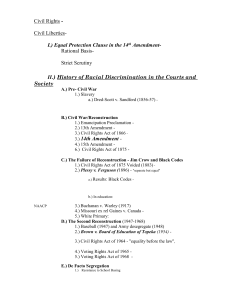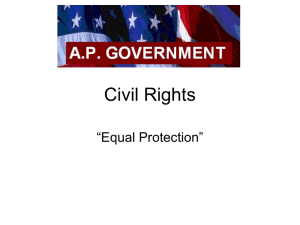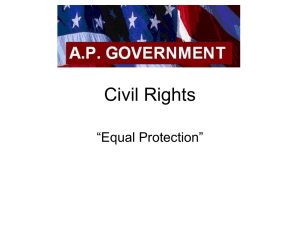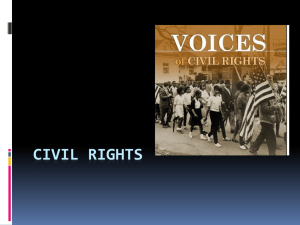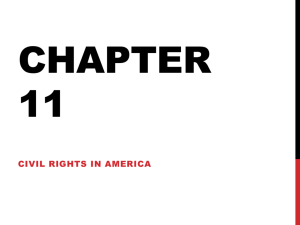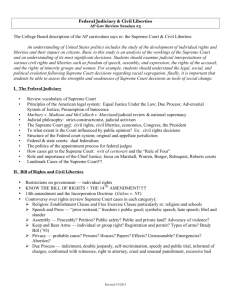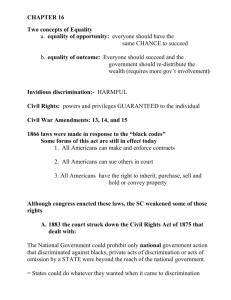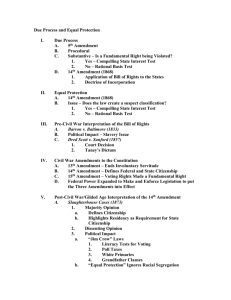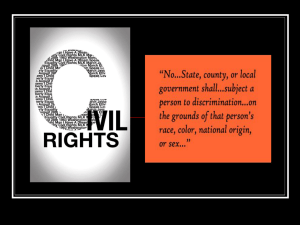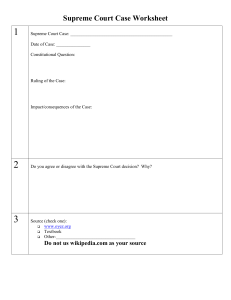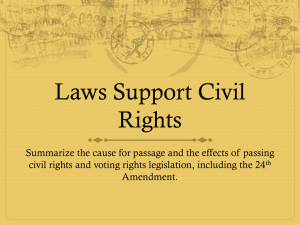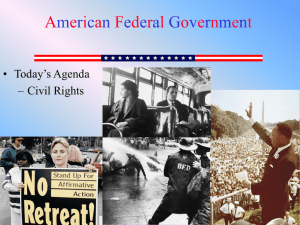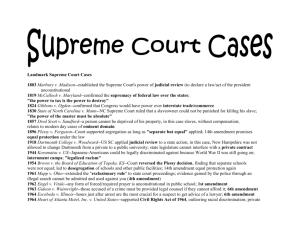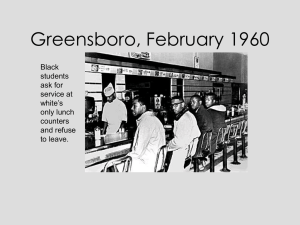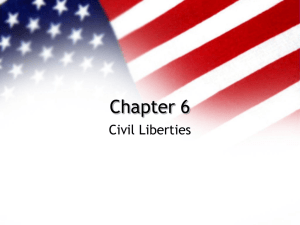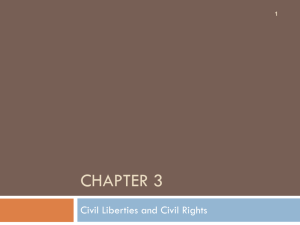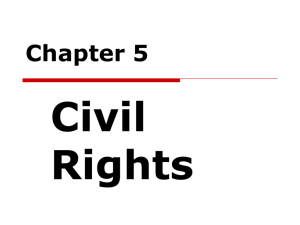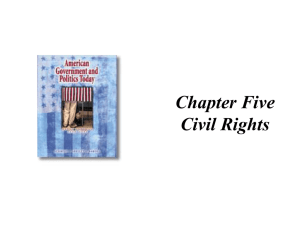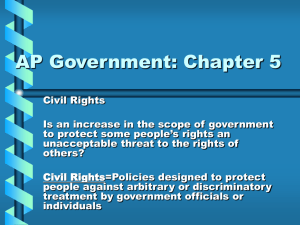Civil Rights - OCPS TeacherPress
advertisement
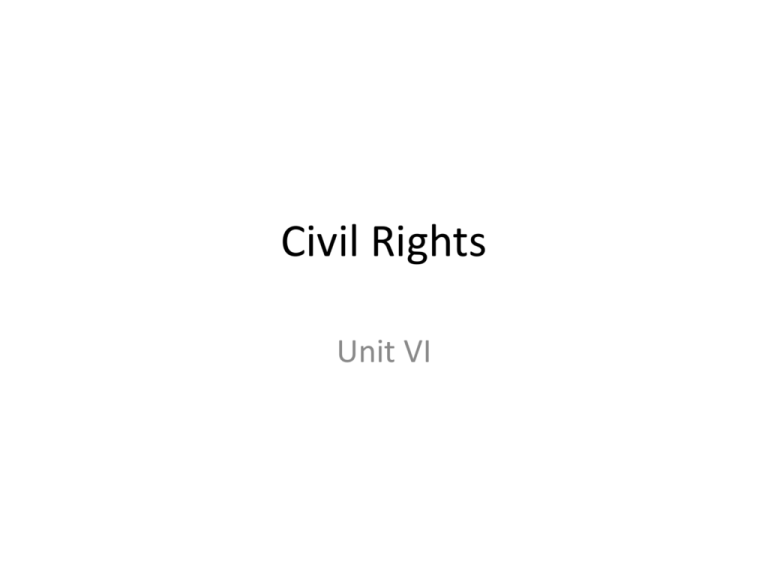
Civil Rights Unit VI VI. Civil Rights and Civil Liberties 5–15% A. The development of civil liberties and civil rights by judicial interpretation B. Knowledge of substantive rights and liberties C. The impact of the Fourteenth Amendment on the constitutional development of rights and liberties I. Conceptions of Equality A. The Declaration of Independence 1. “all men are created equal” 2. Indicates a belief in political equality, legal equality, equality of opportunity B. The Constitution 1. Neither the Constitution or the Bill of Rights uses the word equality 2. 14th Amendment a. Forbids states from denying “equal protection of the laws” b. Plays a key role in the civil rights struggle C. Supreme Court A. Reasonable classification 1. Government must have the power to make reasonable classifications between persons and groups 2. Includes: denying the right to vote to citizens under 18 or high excise tax on cigarettes which smokers must pay B. Strict scrutiny 1. Classification by race and ethnic background is suspect 2. Must be justified by “compelling public interest” II. Struggle for racial equality A. Dred Scot decision (1857) 1. Black people were not citizens and could not petition the courts 2. Established that national legislation could not limit the spread of slavery 3. Repealed the NW Ordinance of 1787 & Missouri Compromise B. Reconstruction Amendments 1. 13th – abolished slavery 2. 14th – former slaves are citizens; invalidates Dred Scott decision 3. 15th suffrage for African American males C. Plessy v. Ferguson (1896) 1. Dispute over a Louisiana law requiring “equal but separate accommodations for the white and colored races” on railroad coaches 2. Supreme court upheld the law 3. Doctrine sanctioned segregation and strengthened the states at the expense of the federal government D. Brown v. Board of Education of Topeka (1954) 1. Racially segregated schools violated Equal Protection clause of the 14th amendment 2. Reversed the separate but equal principle E. The Civil Rights Act of 1964 1. Bill finally passed when the Senate invoked cloture to end 83 days of filibuster 2. Did the following: a. Ended Jim Crow segregation by making discrimination illegal in hotels, motels, restaurants and other public accommodation E. The Civil Rights Act of 1964 b. Prohibited employment discrimination bases on race, color, national origin, religion, gender c. Created Equal Employment Opportunity Commission to monitor d. Authorized the Department of Justice to initiate lawsuits to desegregate public facilities and schools 3. Supreme Court upheld the provisions outlawing segregation in places of public accommodation by ruling that such segregation involved interstate commerce and fell under legislative authority of Congress IMPORTANT!! • AP US GOPO tests have devoted a significant number of multiple choice questions to Brown v. Board of Ed and the Civil Rights Act. • Know that Brown used the Equal Protection Clause of the 14th amendment to reverse Plessy v. Ferguson. • Court used interstate commerce provision to uphold the Civil Rights Act. III. The struggle for African American Voting Rights A. Methods of disenfranchising African American voters 1. 2. 3. 4. Poll taxes Literacy tests White primaries By 1960 only 29% of African Americans of voting age were registered to vote in the South. 61% of whites were registered B. Eliminating the poll tax 1. 24th Amendment (1964) prohibited poll taxes in federal elections 2. In 1966, Supreme Court voided poll taxes in state elections A. The Voting Rights Act of 1965 1. Outlawed literacy tests 2. Legal oversight of voter registration in areas with a history of discriminatory voting practices 3. Improved voter registration disparity D. Racial gerrymandering 1. Following 1990 census, several states created oddly shaped districts to give minority groups a majority 2. Shaw v. Reno (1993): oddly shaped minoritymajority districts held to strict scrutiny 3. Subsequent rulings refined Shaw – use of race as “predominant factor” is unconstitutional IV. Women’s struggle for civil rights A. Original status of women 1. Considered citizens but no political rights 2. Subjected to male-dominated system of family law; for example, women could not divorce their husbands, sign contracts, or dispose of property 3. Denied educational and career opportunities. In 1873, Supreme Court denied the right of women to practice law, saying “The paramount destiny and mission of women are to fulfill the noble and benign offices of wife and mother. This is the law of the Creator.” B. Seneca Falls Convention, 1848 1. Elizabeth Cady Stanton & Lucretia Mott organized 2. Adopted resolutions calling for the abolition of legal, economic, social discrimination against women C. The Fight for suffrage 1. Women’s rights activists disappointed when the 15th amendment failed to give women the right to vote 2. 19th amendment (1920) guaranteed women the right to vote D. The Equal Rights Amendment 1. Congress passed the ERA in 1972 2. 3 states short of the 3/4ths necessary E. Milestones 1. 2. 3. 4. 5. Equal Pay Act of 1963: equal pay for equal work; women earn $0.81 for every $1 men make Civil Rights Act of 1964 1966, Betty Friedan and others found NOW (National Organization for Women) Reed v. Reed (1971) a. Idaho law that preferred a father over a mother as executor violated Equal Protection Clause of 14th amendment b. New standard for judging sex discrimination cases: any law that classifies people on the basis of gender “must be reasonable, not arbitrary and must rest on some ground of difference” Title IX of the Education Act of 1972 forbids discrimination against female students (important in women’s athletics) V. Affirmative Action
